List of kebabs

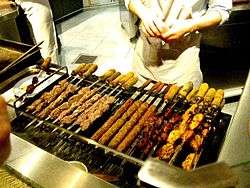
This is a list of kebab variants from around the world. Kebab is a dish of pieces of meat, fish, or vegetables roasted or grilled on a skewer or spit.[1] The dish originated in the Middle East,[2][3] before spreading worldwide.
Afghanistan
Africa
| Name | Image | Description |
|---|---|---|
| Kyinkyinga | A common kebab in West Africa prepared with beef steak or liver that is coated in peanut flour and roasted on skewers.[4] |
Azerbaijan
| Name | Image | Description |
|---|---|---|
| Khan kebab | ||
| Lyulya kebab |  |
(Russian: люля-кебаб) – served skewered or wrapped in lavash bread[5] |
| Sham kebab | ||
| Tava kebab |
China
| Name | Image | Description |
|---|---|---|
| Chenjeh kabab |  |
Uyghur: Kewap, Chinese: 串儿 Chuanr or 羊肉串 Yangrouchuan - The most popular Xinjiang dish in China, being chunks of mutton or mutton fat pierced on metal (or wood or bamboo) skewers, grilled on a coal-fired barbecue, and served with cumin and chili paste. Across Xinjiang, and neighbouring regions such as Kyrgyzstan, the mutton fat is valued equivalent to or more than the meat itself, as it provides sufficient energy during the harsh winter months. It has also become a popular street food all over North and West China, where a wide variety of foods are cooked in such a manner. Chuanr was traditionally made from lamb (yáng ròu chuàn, 羊肉串), which is still the most common, but now, chicken, pork, beef, and various types of seafood are also used. It is typically roasted over charcoal or electric heat, but It is sometimes also cooked by deep frying in oil (popular in Beijing). Pictured are Barbecued chuanr lamb sticks. |
Cyprus
| Name | Image | Description |
|---|---|---|
| Sheftalia | 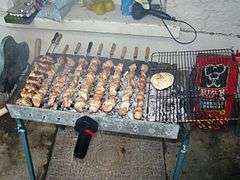 |
A traditional Cypriot sausage made of ground pork or lamb and wrapped in caul fat that is served alone or in a pita, usually with tomato, cucumber, parsley, and lemon |
| Souvlaki |  |
Skewers consisting of pork, chicken or lamb that is barbecued. Pictured is pork souvlaki with fried garlic bread and lemons. |
Greece
| Name | Image | Description |
|---|---|---|
| Gyros |  |
Made from chopped meat, usually pork or chicken, formed into a large loaf for slow-roasting on a vertical rotisserie cooker, the auto-donner. (See also doner kebab.) Thin portions are shaved off and served in a pitta bread with onion and Greek yogurt-cucumber-garlic sauce, tzatziki. Popularized in US by Greek restaurateurs in the Greektown, Chicago neighborhood. |
| Souvlaki |  |
Souvlaki (skewer) consists of small skewers of pork, barbecued, then served plain, in a pitta, or with salad. Chicken and lamb are also sometimes used. It is sometimes served on a skewer, or as a dinner in combination with rice, potatoes, and tzatziki sauce. |
India
| Name | Image | Description | |
|---|---|---|---|
| Bihari kabab | |
Skewered pieces of meat marinated in spice. Originally a dish from the non-vegetarian cuisine, Muslims invented Bihari kabab of the North Indian state of Bihar as it is made out of beef . It has spread to other countries.[6] | |
| Boti kebab | |||
| Achari Tikka | |||
| Chicken tikka | .jpg) |
Another tandoori kebab, made of cubed chicken marinated with yogurt and spices | |
| Dora kabab | |||
| Galawat kabab | A variant of Shami kebab made without any admixture or binding agents and comprising just the minced beef (Muslim origin) and the spices. Speciality of Lucknow. | ||
| Hariyali kabab | Punjabi style chicken tikka or kabab made with combination of mint and coriander | ||
| Kakori kabab | Made of minced beef meat with spices, a specialty of Muslims of Lucknow & Delhi | ||
| Galauti kebab | |||
| Hariyali kebab | |||
| Tangri kebab | Chicken legs roasted on open fire with hot spices and laced with butter or ghee | ||
| Kastoori kebab | |||
| Dahi ke kabab | |||
| Burra kebab | |||
| Kalmi kebab |  |
Kalmi kebab is pictured on the left in the image. | |
| Paneer kabab | Vegetarian kebab | ||
| Reshmi kabab | A traditional kebab of Mughlai cuisine that is prepared with marinated chicken, lamb or beef[7] | ||
| Shami kebab |  |
Made of minced beef, with paste of lentils and chopped onion and coriander and green chillies usually added to the mixture, which is kneaded in a disc-like shape and fried. Best results are obtained when fried in animal fat or ghee in a brass utensil over a coal fire. In some places, a binding agent is used to keep the kebab together. | |
| Shikampur kabab | |||
| Sutli Kebab |  |
Sutli kabab is made by wrapping a paste of meat & spices around a metal sheekh, tying it with a cotton thread & then heating it in a barbeque pit. Once the kabab is done, the thread is removed & the kabab is served.[8] |
Iran
| Name | Image | Description |
|---|---|---|
| Berenj goje kabab | ||
| Chelow kabab (rice with kebab) |  |
Is one of the most common forms of serving kebab in Iran which combines a variety of Persian kebabs with saffroned Basmati rice, lavash (a paper-thin bread), grilled tomato, raw onions, bell peppers, mushrooms and sumac and often a side of salad shirazi, mast-o-khiar and doogh (nowadays carbonated). An old Iranian tradition is to break a raw egg yolk over the rice, along with plenty of butter, just before serving, but not many follow this tradition anymore. |
| Dandeh kebab | ||
| Ghaz kabab | ||
| Joujeh kabab |  |
Grilled chicken on skewers |
| Kabab bakhtiari | Combination of Jujeh kabab and kabab barg | |
| Kabab barg |  |
Grilled marinated sirloin. |
| Kabab barreh | Grilled lamb, typically marinated in yogurt with parsley | |
| Kabab chenjeh | Grilled lamb prepared similar to shish kebab, without the vegetables | |
| Kabab digi | Pan Kabab | |
| Kabab hosseini | Lamb or beef cooked on skewers with onions, tomatoes and green peppers | |
| Kabab isphahani | ||
| Kabab Jigar-o Del-o Gholveh | ||
| Kabab kermanshahi | ||
| Kabab koobideh |  |
Ground beef or lamb (usually sirloin), often mixed with parsley and chopped onions |
| Kabab kurdi | Ground lamb or beef, onions, garlic, and tomatoes | |
| Kabab loghmeh | Minced lamb meatballs first fried and the grilled over charcoal fire, eaten with chopped parsley, chopped onions, and sumac. A summer outing favorite | |
| Kabab mahitabeh | Pan fried Kabab | |
| Kabab rashti | Also known as Kabab Shomali, includes almond & pistachio & barberry | |
| Kabab shamshiri | It is a kabab with kabab-barg on one side of skewer and kabab-kubideh on the other | |
| Kabab shirazi | ||
| Kabab soltani | Combination of kabab koobideh and kabab barg | |
| Kabab torsh |  |
(Gilan, northern Iran) Also called (tursh-e-kabab) grilled beef marinated in a mixture of pomegranate juice, crushed walnuts, parsley, crushed garlic, and olive oil |
| Kabab va nun ('Kabab with bread') | ||
| Kabab vaziri | ||
| Kabab-e donbalan | Lamb fries kabab | |
| Kababe shandiz | ||
| Sonnati kabab |
Korea
| Name | Image | Description |
|---|---|---|
| Dakkochi | A Korean chicken kebab |
Levant
Kebab halabi is a kind of kebab served with a spicy tomato sauce and Aleppo pepper, very common in Syria, Lebanon and the Galilee region in Northern Palestine, named after the city of Aleppo (Halab). Kebab halabi has around 26 variants[9] including:
| Name | Image | Description |
|---|---|---|
| Kebab hindi | Rolled meat with tomato paste, onion, capsicum and pomegranate molasses | |
| Kebab kamayeh | Soft meat with truffle pieces, onion and various nuts | |
| Kebab karaz | For cherry kebab in Arabic – meatballs (lamb) along with cherries and cherry paste, pine nuts, sugar and pomegranate molasses. It is considered one of Aleppo's main dishes, especially among Armenians. | |
| Kebab khashkhash |  |
Rolled lamb or beef with chili pepper paste, parsley, garlic and pine nuts. Pictured is Kebab khashkhash from Aleppo. |
| Kebab siniyye | For tray kebab in Arabic – lean minced lamb in a tray added with chili pepper, onion and tomato | |
| Kebab tuhal | Lamb rounds stuffed with parsley, hot green peppers and pine kernels[10] | |
| Shawarma | Similar to a doner kebab, made with chunks of lamb meat |
Pakistan
| Name | Image | Description |
|---|---|---|
| Chapli kebab |  |
A delicacy of Pakistan from Khyber Pakhtunkhwa province – marinated beef in spices and deep fried flat |
| Lola kabab/Gola kabab | Kabab of Pakistan and Afghanistan – rolled meatballs originating in Peshawar and Kandahar | |
| Seekh kebab | 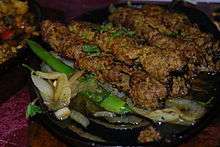 |
Kebab of Pakistan – prepared with minced meat with spices and grilled on skewers. It is cooked in a Tandoor, and is often served with chutneys or mint sauce. It is often included in tandoori sampler platters, which contain a variety of tandoor cooked dishes. A seekh kebab can also be served in a naan bread much like döner kebab. Seekh kebabs are part of the traditional Pakistani diet. |
| Shami kebab |  |
Made of minced meat, with paste of lentils and chopped onion and coriander and green chillies usually added to the mixture, which is kneaded in a disc-like shape and fried. Best results are obtained when fried in ghee. In some places, a binding agent is used to keep the kabab together. |
| Tandoori kebab | Kabab of India/Pakistan – chunks or strips of meat marina | |
| Malai tikka | Kabab of Pakistan – chunks or strips of chicken marinated in a white yoghurt and garlic sauce and grilled | |
| Reshami kebab | Kabab of Pakistan – minced chicken adequately seasoned and then barbecued on a charcoal grill | |
| Bihari kebab | Kabab of Pakistan – chunks or strips of lean beef, marinated in a spicy yoghurt/chilli marinade and tenderized to perfection before slowly grilled on a charcoal flame |
Portugal
| Name | Image | Description |
|---|---|---|
| Espetadas |  |
Meat skewer, usually beef |
Spain
| Name | Image | Description |
|---|---|---|
| Pincho moruno |  |
Meat skewer, usually made of chicken or pork, sliced in cubes, marinated in paprika and other spices. |
Turkey
| Name | Image | Description |
|---|---|---|
| Adana kebabı |  |
Also known as kıyma kebabı – kebab with hand-minced (zırh) meat mixed with chili on a flat wide metal skewer (shish); associated with Adana region although very popular all over Turkey.[11] |
| Ali Paşa kebabı (Ali Pasha kebab) | Cubed lamb with tomato, onion and parsley wrapped in filo[11] | |
| Alinazik kebab | Ground meat kebab sautéed in a saucepan, with garlic, yogurt and eggplants added | |
| Antep kebabı |  |
Half-fat minced meat mixed with thin slices of the same meat and made into balls and cooked between thick slices of eggplant |
| Bahçıvan kebabı[12] | Boneless lamb shoulder mixed with chopped onions and tomato paste | |
| Beykoz kebabı | Tomato and onion flavoured lamb, wrapped in aubergine slices and garnished with lamb brains[11] | |
| Beyti kebab | 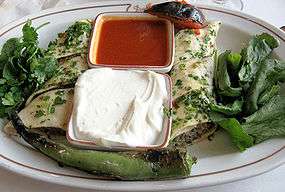 |
Ground lamb or beef, seasoned and grilled on a skewer, often served wrapped in lavash and topped with tomato sauce and yogurt, traced back to the famous kebab house Beyti in Istanbul and particularly popular in Turkey's larger cities.[13] |
| Bostan kebabı | Lamb and aubergine casserole.[11] | |
| Cağ kebabı (spoke kebab) |  |
Cubes of lamb roasted first on a cağ (a horizontal rotating spit) and then on a skewer, a specialty of Erzurum region with recently rising popularity |
| Çardak kebabı[14] | Stuffed lamb meat wrapped in a crepe or filo. | |
| Ciğer kebabı (liver kebab) | Lamb liver kebab on a skewer (a.k.a. ciğer şiş) | |
| Çökertme kebabı | Sirloin veal kebap stuffed with yogurt and potatoes | |
| Çöp şiş (small skewer kebab) | A specialty of Selçuk and Germencik near Ephesus, pounded boneless meat with tomatoes and garlic marinated with black pepper, thyme and oil on wooden skewers[15] | |
| Doner kebab |  | |
| İskender kebap | |
Döner kebap served with yogurt, tomato sauce and butter, originated in Bursa. The kebab was invented by İskender Efendi in 1867. He was inspired from Cağ kebab and turned it from horizontal to vertical. |
| İslim kebabı (stew) |  |
Another version of the aubergine kebab without its skin, marinated in sunflower oil[11][15] |
| Kağıt kebabı |  |
Lamb (or veal) cooked in a paper wrapping[15] |
| Kılıç şiş | Brochette of swordfish[11] | |
| Şiş köfte |  |
Also known as Shish köfte – minced lamb meatballs with herbs, often including parsley and mint, on a stick, grilled |
| Kuyu kebabı (pit kebab) | Prepared from the goat it is special for Aydın region, similar to tandır kebabı | |
| Kuzu şiş | Shish kebap prepared with marinated milk-fed lamb meat | |
| Manisa kebabı | This Manisa region version of the kebab is smaller and flat size shish meat on the sliced pide bread, flavored with butter, and stuffed with tomato, garlic and green pepper. | |
| Orman kebabı (forest kebab) | Lamb meat on the bone and cut in large pieces mixed with carrots, potatoes and peas[11] | |
| Patates kebabı[16] | Beef or chicken mixed with potatoes, onions, tomato sauce and bay leaves | |
| Patlıcan kebabı (aubergine kebab) | A unique kebap meat marinated in spices and served with aubergines, hot pide bread and a yogurt sauce[15] | |
| Şiş kebabı | .jpg) |
Prepared with fish, lamb or chicken meat on thin metal or reed rods, grilled[11][15] |
| Şiş tavuk | Also known as Tavuk şiş or – Yogurt-marinated chicken grilled on a stick[15] | |
| Sivas kebabı | Associated with the Sivas region, similar to Tokat kebab but especially lamb ribs are preferred and it also differs from Tokat kebabı on the point that there are no potatoes inside | |
| Tandır kebabı (tandoor kebab) | Lamb pieces (sometimes a whole lamb) baked in an oven called a tandır, which requires a special way of cooking for hours. Served with bread and raw onions.[11] | |
| Tas kebap (veal stew) | Stewed meat in a bowl, beginning with the cooking of the vegetables in butter employing a method called yağa vurmak, ("butter infusion"), before the meat itself is cooked in the same grease | |
| Testi kebabı (earthenware-jug kebab) | Ingredients are similar to çömlek kebabı, prepared in a testi instead of a güveç, generally found in Central Anatolia and the Mid-Western Black Sea region | |
| Tire kebabı | Minced meat cooked on sheesh and served with maydanoz and sauce, on top of special tire bread | |
| Tokat kebabı | Associated with the Tokat region, it is made with marinated lamb, grilled inside an oven, together with aubergines, tomatoes, potatoes, entire onions and garlics and served over a special flatbread called lavaş (a thicker yufka) and softened with the juice of the meat and tomatoes. | |
| Urfa kebabı | From Urfa, similar to Adana kebab, but not spicy | |
Others
| Name | Image | Description |
|---|---|---|
| Chislic |  |
This is a migration of Russian culture into South Dakota by the German-Russian population. |
| Salmon kebabs | A kebab popular throughout the Pacific Northwest's United States coastal areas, especially during salmon runs[17] | |
| Samak kebab | Grilled fish on a stick | |
| Satay | 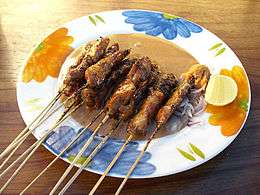 |
A Southeast Asian dish consisting of diced or sliced meat, skewered and grilled over a fire, then served with various spicy seasonings |
| Senjeh lebab | ||
| Shashlik |  |
Shashlyk, meaning skewered meat, was originally made of lamb. Nowadays it is also made of pork or beef depending on local preferences and religious observances. |
| Shishleek | A term with various uses: in Iran it refers to grilled baby lamb chops (usually from the leg), typically marinated; in Palestine, to grilled pieces of lamb, and in Israel, to grilled turkey | |
| Sosatie |  |
A dish of the Cape Malay people of South Africa |
| Stonner kebab | A Scottish dish | |
| Suya: Kewap | A popular spicy meat kebab enjoyed by many across West Africa. Originally from Nigeria, this kebab has tastes of peanuts and spicy pepper and is sold by street vendors as a snack or entire meal. The kebabs are enjoyed with onion and bell pepper pieces. | |
| Kabab Memuleh b'hatzilim | A kebab balls made of minced beef, garlic, parsley, baharat, salt, black pepper, onions and cumin which stuffed with a mixture of fried or grilled eggplants and tahini.
Originally from Israel. | |
| Skewered goose liver | A dish from southern Tel Aviv. It is seasoned with salt and black pepper and sometimes with spices like cumin, cinnamon, paprika, nutmeg, allspice and turmeric. | |
| Yakitori | Yakitori (Japanese: 焼き鳥?, lit. grilled chicken) is a Japanese type of skewered chicken.
The preparation of Yakitori involves skewering the meat with kushi (串?), a type of skewer typically made of steel, bamboo, or similar materials. Afterwards, they are grilled over a charcoal fire. During or after cooking, the meat is typically seasoned with tare sauce or salt. |
Gallery
 Iranian joujeh kabab
Iranian joujeh kabab- Kufta kebab Plate

 Döner kebab in a bun, as served in Germany
Döner kebab in a bun, as served in Germany Ürumqi, Xinjiang kebab street stand
Ürumqi, Xinjiang kebab street stand
References
- ↑ Kebab, Oxford Dictionaries
- ↑ Encyclopedia of Jewish Food. Retrieved 2 November 2014.
- ↑ Punjabi Khana. Retrieved 2 November 2014.
- ↑ Raichlen, S.; Fink, B. (2008). The Barbecue! Bible. Workman Pub. pp. 157–158. ISBN 978-0-7611-4943-9. Retrieved May 23, 2016.
- ↑ "recipe". Retrieved 2 November 2014.
- ↑ "Bihari kabab". ALL THINGS PAKISTAN. Retrieved 2 November 2014.
- ↑ "Reshmi Kebab (Silken Kebabs)". Allrecipes.com. Retrieved 2 November 2014.
- ↑ "Streetfood - Adam's Kabab (Phears Lane, Chuna Gali, near Central Metro station, Kolkata)". 22 October 2012.
- ↑ "Kuwait News Agency (KUNA)". Retrieved 2 November 2014.
- ↑ The Cooking of the Middle East, Time-Life Books (1969)
- 1 2 3 4 5 6 7 8 9 Turkish Cookery by M.Günür ISBN 975-479-100-7
- ↑ Tatlıdan, tuzluya Türk sofrası: alaturka - alafranga ; yemekler ve tatlılar. Geçit Kitabevi. 1982.
- ↑ "Three Renowned Turkish Restaurants: Beyti Meat Restaurant". Skylife - Turkish Airlines magazine (12): 1–4. 2000.
- ↑ Banu Atabay. Mütevazi Lezzetler Deutsch. Banu Atabay. pp. 98–. GGKEY:QQKUPZ6WZ7J.
- 1 2 3 4 5 6 The Complete Book of Turkish Cooking , A.Algar (1985) ISBN 0-7103-0334-3
- ↑ Metin Sözen (2005). Taşın belleği Mardin. Yapı Kredi Kültür Sanat Yayıncıkık. ISBN 978-975-08-1029-9.
- ↑ Rosemary-Lime Wild Alaska Salmon Kabobs | Whole Foods Market
External links
| Wikimedia Commons has media related to Kebabs. |
| Look up kebab in Wiktionary, the free dictionary. |
- Kebab at the Open Directory Project
